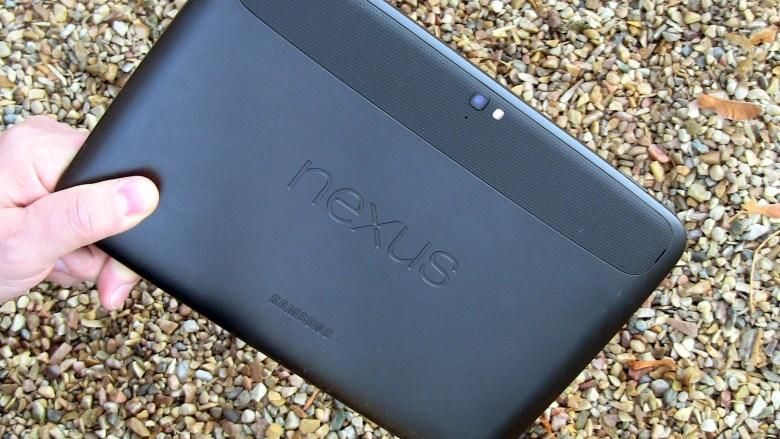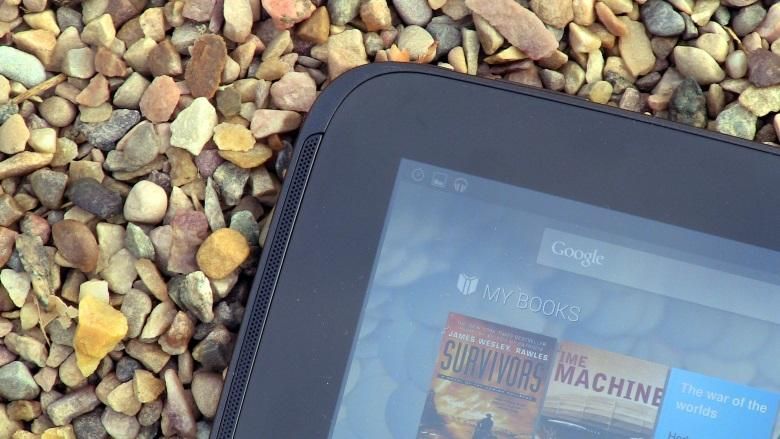Yes, you read the headline correctly! Although the Nexus 9 is the Google-branded tablet that was recently announced and is currently available in the Play Store, it’s got us scratching our heads. Android 5.0 Lollipop is great, no question, and having the (arguably) first 64-bit Android-powered device certainly sets your status well above those of us mere mortals that are stuck in the archaic days of 32-bit processors (queue the Apple fanboys touting the fact that “their” platform has had 64-bit for a “long long time”).
We’ve taken the Nexus 9 head to head against the iPad Air 2 and even ran a cost versus features analysis between the two platforms. We’ve even compared the Nexus 9 to a handful of other Android-powered tablets and asked you which you thought was the best bang for your buck.
With all that comparing, we seem to have left one tablet out of the mix: the Nexus 10.
Nexus 10
Who’s to say whether the shape is distinctive, or just to fend of lawsuits.
Release in 2012, the Nexus 10 was a formidable beast powered by a 32-bit dual-core processor clocked at 1.7GHz (which was decent back in the day), unlike today’s Nexus 9, which sports a 64-bit dual-core processor clocked at 2.3GHz. RAM and storage options are the same (though both should have faster access times thanks to today’s technology versus that from two years ago).
It’s the screen where the differences really come into play. The Nexus 10, as its name implies, has a slightly larger screen and includes a bit more pixels. It also crams those pixels together more densely than the Nexus 9. Powering the bigger screen is a much bigger battery: 9000mAh compared to 6700mAh. Sure, the Nexus 10 is slightly larger and a bit heavier, but for the extra PPI, screen space, and battery capacity, I think I’m okay with that!
The big difference has been the operating system: the Nexus 9 ships with Android 5.0 Lollipop, and the Nexus 10 was stuck on KitKat – but all that’s changed now. As of this writing, if you haven’t gotten an OTA for your Nexus 10, you can manually download and flash Lollipop to it.
To top it all off, the Nexus 10 is extremely well-built. None of that “squishy back” nonsense the Nexus 9 has.
Although you can no longer buy the Nexus 10 directly from Google you can still find it online, and generally for over US$100 less than the Nexus 9. If I were to buy a large-size tablet today, you’d have a hard time convincing me to get a Nexus 9 instead of an Nexus 10!
Comparision
[table]Component,Nexus 9, Nexus 10
Screen size,8.9 inches,10.1 inches
Screen type,IPS LCD,Super PLS TFT
Resolution,2048 x 1536,2560 x 1600
Pixel density,287 ppi,299 ppi
SoC,NVIDIA Tegra K1 – 64 bit,Cortex-A15
Type,Dual-core,Dual-core
Speed,2.3 GHz,1.7 GHz
GPU,Kepler 192-core,Mali-T604
RAM,2GB,2GB
Storage,16GB or 32GB,16GB or 32GB
Expansion,None,None
Camera,8MP f/2.4 autofocus,5MP
Flash,LED,LED
Front-facer,1.6MP f/2.4 fixed focus,1.9MP
Battery,6700mAh,9000mAh
OS,Android 5.0 Lollipop,Upgradable to Android 5.0 Lollipop
Bluetooth,Bluetooth 4.1,Bluetooth 3.0 / A2DP
WiFi,802.11ac 2×2 (MIMO),Wi-Fi 802.11 b/g/n
NFC,Present,Dual Side
Infrared,None,None
Sensors,GPS / GLONASS / gyroscope / accelerometer / magnetometer / Hall effect / ambient light,GPS / GLONASS / gyroscope / accelerometer / proximity / compass / barometer
Build,Brushed metal sides,Soft-touch polycarbonate
Size,153.68 x 228.25 x 7.95mm / 425g, 177.6 x 263.9 x 8.9 mm / 603g
[/table]
For even more details make sure you check out our /2014/11/14/google-nexus-9-review and our Nexus 10 review.


